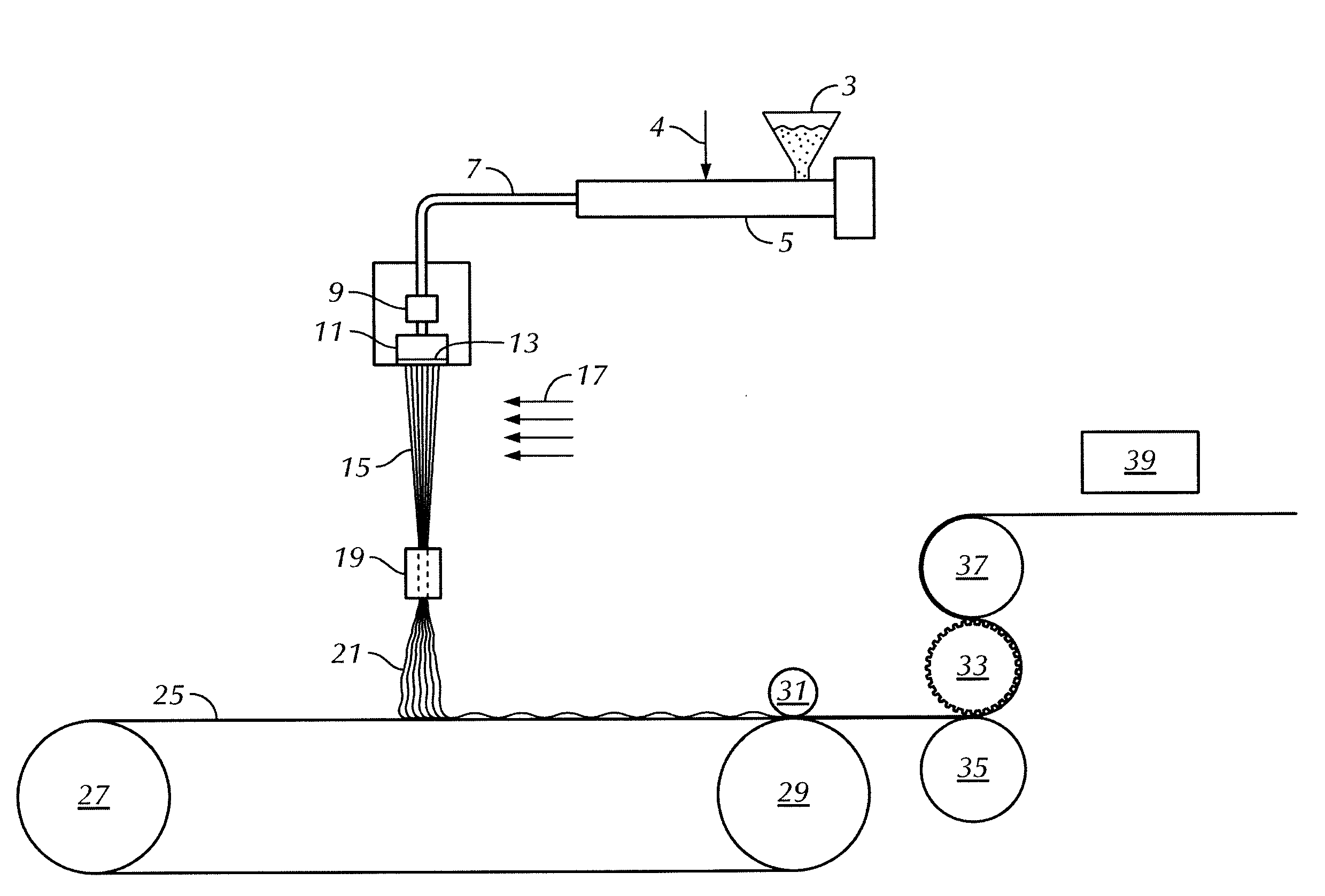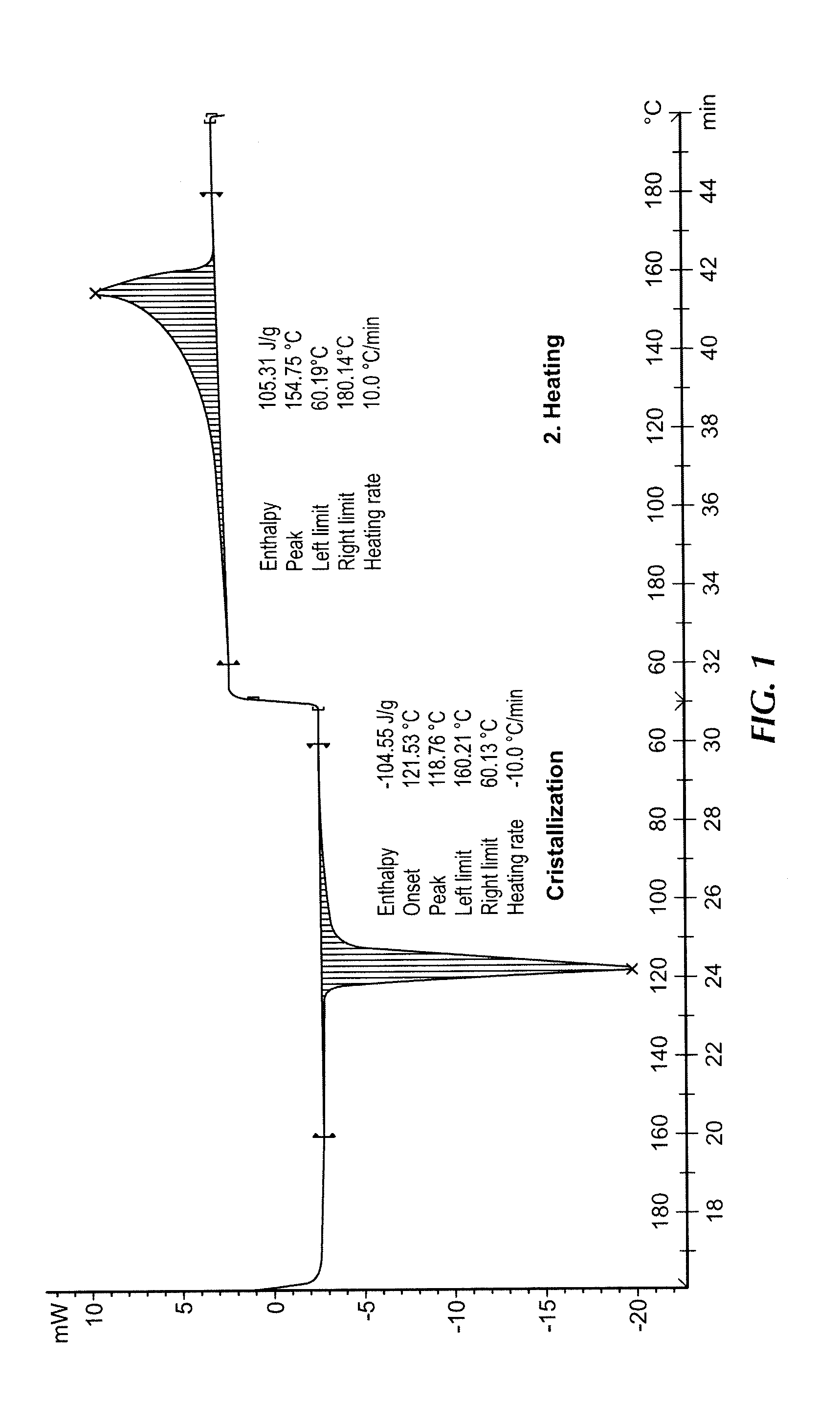Nonwoven and yarn polypropylene with additivation
a technology of additive and nonwoven polypropylene, which is applied in the direction of monocomponent polypropylene artificial filaments, domestic articles, applications, etc., can solve the problems of unstable process conditions, limited filament spinning speed of bcf, and decrease in elongational viscosity, so as to improve the ability to process polyolefins
- Summary
- Abstract
- Description
- Claims
- Application Information
AI Technical Summary
Benefits of technology
Problems solved by technology
Method used
Image
Examples
example 1
Melt Properties
[0054]Sample 1
[0055]A metallocene polypropylene (mPP), formed using a metallocene catalyst (MCC A013) and having a melt flow rate of approximately 30 g / 10 min (ISO 1133, 230° C. with 2.16 kg weight) is melt blended with a beta nucleating agent N′,N′dicyclohexyl-2,6 naphtalene dicarboxamid (commercially available as NJ-Star NU-100 from RIKA), at a loading of 300 ppm, by weight. Using the Rheotens Test (employing the Rheotens model 71.97 elongational viscosity tester from Göttfert) a curve of the strain velocity versus elongation viscosity (the speed of the filament uptake wheel of the Rheotens Test equipment) is produced. The Rheotens Test is conducted in the following manner. The Rheotens trial was performed by continuously extruding a polymer strand through a die with a length of 30 mm and a diameter of 2 mm which subsequently was received by the take-up wheels of the Rheotens equipment. The distance between the exit of the die and the nib point of the Rheotens take-...
example 2
Spinning Tests
[0061]Sample 4
[0062]The mPP and beta nucleating agent as described for Sample 1 were tested on a high speed spinning line (using the Fourné Laboratory and Pilot Melt Spintester Spinning Line by Fourné Polymertechnik GmbH) to determine the maximum spinning speeds for the beta nucleated polypropylene. The polymer is melted in an extruder at temperatures between 220° C. and 230° C. The molten polymer is extruded through 18 dies of 0.25 mm diameter and an L / D ratio of 2. The filaments exiting the spinneret are then taken up by a take-up godet leading them over a second godet to the winder on which the final yarn is wound on spools. The take-up godet with adjustable speed defines the spinning speed of the filaments. The maximum spinning speed is reached when the filaments start to rupture. The test results are shown in Table 1.
[0063]Sample 5
[0064]The mPP blended with the nucleating agent as described for Sample 2 were tested on a high speed spinning line (a Fourné Spinning ...
example 3
[0068]Various blends of a metallocene polypropylene having a melt flow rate of approximately 30 g / 10 min (ISO 1133, 230° C. with 2.16 kg weight), a beta nucleating agent (A=NJ-Star NU-100) and a nucleating agent (B=MILLAD NX8000) were formed as detailed in Table 2. Comparative samples included the metallocene polypropylene without a nucleating agent and a Ziegler-Natta polypropylene (PP 3155, an isotactic polypropylene having a melt flow rate of approximately 35 g / 10 min, available from ExxonMobil Chemicals Corporation, Baytown, Tex.).
TABLE 2Polymer Nucleating Nucleating AgentTypeAgentLoading (ppm)Comparative mPP——Sample 7Sample 8mPPA 500Sample 9mPPA2000Sample 10mPPB1000Sample 11mPPB2000Sample 12mPPB4000Comparative Z / N PP——Sample 13
[0069]The properties of the melt are measured using a Rheotens Test as described above. The test results are illustrated in FIGS. 5-9.
[0070]As shown in FIG. 5, nucleating agent “A” does not result in a change in the draw force required for the metallocene...
PUM
| Property | Measurement | Unit |
|---|---|---|
| average diameter | aaaaa | aaaaa |
| melt flow rate | aaaaa | aaaaa |
| melt flow rate | aaaaa | aaaaa |
Abstract
Description
Claims
Application Information
 Login to View More
Login to View More - R&D
- Intellectual Property
- Life Sciences
- Materials
- Tech Scout
- Unparalleled Data Quality
- Higher Quality Content
- 60% Fewer Hallucinations
Browse by: Latest US Patents, China's latest patents, Technical Efficacy Thesaurus, Application Domain, Technology Topic, Popular Technical Reports.
© 2025 PatSnap. All rights reserved.Legal|Privacy policy|Modern Slavery Act Transparency Statement|Sitemap|About US| Contact US: help@patsnap.com



